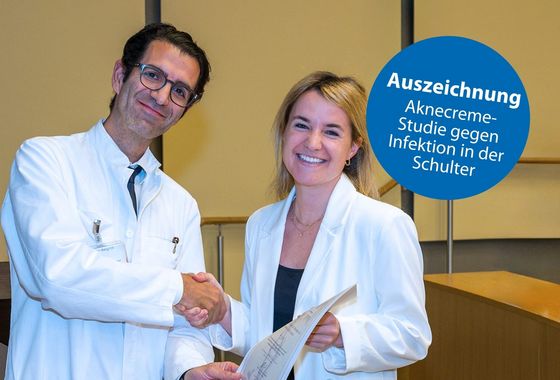Together with many other types of bacteria, the skin bacterium Cutibacterium acnes acts as a protective film for a healthy skin climate, also in the shoulder area. Yet the acne bacterium has two sides: on the one hand, it protects the skin – apart from on the face of pubescent adolescents – on the other hand, it can trigger inflammations and complications in subcutaneous tissue.
When pain occurs due to infections following operations on the shoulder joint, acne bacteria play a part in over 60 % of cases. They are detected at the source of infection during the necessary follow-up operations. Thorough disinfection of the surgical site and antibiotic treatment are evidently unable to prevent their penetration.
However, if commercial acne cream is generously applied to the relevant shoulder every evening for a week before the operation, these acne bacteria no longer penetrate as far as the shoulder joint capsule. This was the finding of a recent study conducted among 60 patients at Balgrist University Hospital.
Two properties are critical for determining whether the acne bacteria can get as far as the joint capsule. Firstly, they primarily colonize sebaceous glands in the lower skin layer, especially around the hair root, and thus avoid surface skin disinfection. Secondly, they protect themselves with an antibiotic-resistant shell. “If the acne bacterium encapsulates itself to shield itself from antibiotics and thus reaches the shoulder joint capsule, it can infect the material inserted there, for example the prosthesis,” explained Dr. med. Ines Unterfrauner, first-time author of the studies. She added: “When cutting through the subcutaneous tissue during the operation, there is a risk that the bacterium gets inside the joint.”
The commercial acne cream selected for the study was proven to be effective because it contains two highly effective substances: the antibacterial substance benzoyl peroxide and the antifungal agent miconazole nitrate that, according to laboratory studies, also successfully eliminates antibiotic-resistant bacteria.
Sixty adult patients with an average age of 59 took part in the Balgrist study between November 2018 and May 2020. During the open shoulder operation, they first either received a prosthetic replacement joint or the joint was stabilized using the Latarjet procedure. Before the start of the study, the intended shoulder of all patients was examined for acne bacteria using a swab (sample 1). Half of the patients then applied Widmer Acne Creme Plus Widmer to the affected shoulder in the evening seven days before the procedure, while the other half did not. A further skin sample was taken from all patients in the operating theater before making the cut (sample 2). Samples of subcutaneous tissue (sample 3) and shoulder joint capsule (sample 4) were then taken during the operation. In 60 % of all patients, the shoulder was inhabited by acne bacteria prior to the start of the study (sample 1). Among these 60 %, the effectiveness of the acne cream could be seen before the procedure (sample 2). Here, the skin was free of acne bacteria in 10 of 18 patients. Among the subcutaneous samples, 17 of 18 patients were free of acne bacteria and, in particular, the joint capsule (sample 4) was free of acne bacteria in all patients treated with acne cream. In contrast, acne bacteria were found in the joint capsule in 4 of 19 untreated patients. In the subcutis (sample 3), 17 of 19 patients were free of acne bacteria, while only 6 out of 19 patients had no acne bacteria on the surface of the skin. If a comparison is performed between all participating patients, including those who had no acne bacteria on their skin in sample 1, the result is even clearer: acne bacteria was found in the joint capsule in 0 of 30 patients treated with the acne cream but in 5 patients who had not received the acne cream.
The Balgrist study also shows that acne bacteria in the joint capsule do not necessarily have to result in infections or inflammations. None of the patients, not even those with a positive acne bacteria result, had to be operated on again during the eleven-month follow-up period due to infections.
For first-time author Unterfrauner the most significant part of the study is the fact that, for the first time, the combined effect of the antibacterial substance benzoyl peroxide and the antifungal agent miconazole nitrate could be seen for the first time in operative procedures, as: “Studies with antibiotic treatment have not worked and antibiotics also have the disadvantage that they can develop resistance.”
Prof. Samy Bouaicha, who was responsible for running the study, referred to the practical benefit: “The pleasing results of our prospective study have led to our Shoulder Surgery team at Balgrist University Hospital routinely administering the acne cream for topical application on our patients a few days before planned surgical procedures.”
The study, which was published in the renowned Journal of Shoulder and Elbow Surgery in May 2022, has been awarded three prizes: the Neviaser Award for the best clinical paper from the Society of American Shoulder and Elbow Surgeons, the EFORT Free Paper Award Orthopedics for the best paper from the European Federation of National Associations of Orthopedics and Traumatology, and the Balgrist Research Award in Orthopedics for the best clinical paper from Balgrist University Hospital.
Contact for further information
Gregor Lüthy, Head of Corporate Communication
Balgrist University Hospital
+41 44 386 14 15
Email

